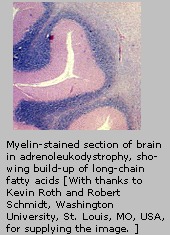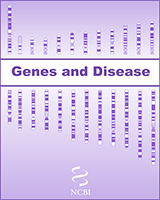NCBI Bookshelf. A service of the National Library of Medicine, National Institutes of Health.
National Center for Biotechnology Information (US). Genes and Disease [Internet]. Bethesda (MD): National Center for Biotechnology Information (US); 1998-.

Adrenoleukodystrophy (ALD) is a rare, inherited metabolic disorder that afflicts the young boy Lorenzo Odone, whose story is told in the 1993 film "Lorenzo's oil." In this disease, the fatty covering (myelin sheath) on nerve fibers in the brain is lost, and the adrenal gland degenerates, leading to progressive neurological disability and death.
People with ALD accumulate high levels of saturated, very long chain fatty acids in their brain and adrenal cortex because the fatty acids are not broken down by an enzyme in the normal manner. So, when the ALD gene was discovered in 1993, it was a surprise that the corresponding protein was in fact a member of a family of transporter proteins, not an enzyme. It is still a mystery as to how the transporter affects the function the fatty acid enzyme and, for that matter, how high levels of very long chain fatty acids cause the loss of myelin on nerve fibers.
More recently, all the transporters related to ALD protein have been found in the yeast Saccharomyces cerevisiae, and a mouse model for the human disease has been developed. These and other molecular biology approaches should further our understanding of ALD and hasten our progress toward effective therapies.
- Genome view see gene locations
- Entrez Gene collection of gene-related information
- BLink related sequences in different organisms
- Research articles online full text
- Books online books section
- OMIM catalog of human genes and disorders
- GeneReviews a medical genetics resource
- Fact sheet from The National Institute of Neurological Disorders and Stroke, NIH
- Adrenoleukodystrophy - Genes and DiseaseAdrenoleukodystrophy - Genes and Disease
Your browsing activity is empty.
Activity recording is turned off.
See more...
